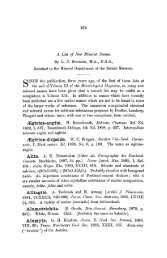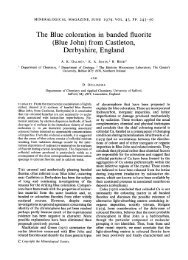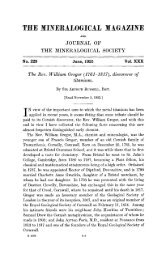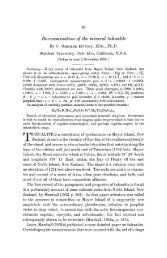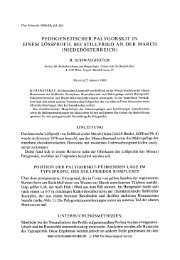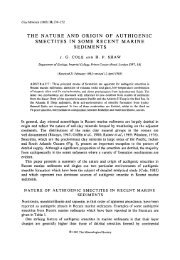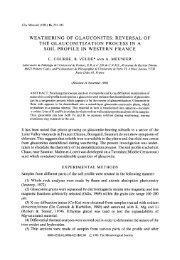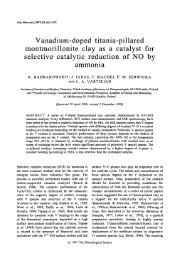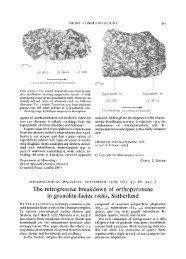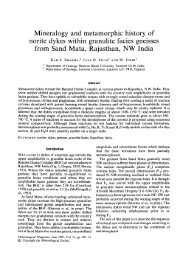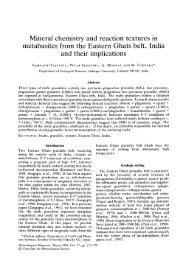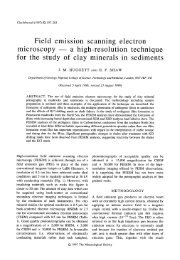Clay mineral assemblages in flysch from the Campo de Gibraltar ...
Clay mineral assemblages in flysch from the Campo de Gibraltar ...
Clay mineral assemblages in flysch from the Campo de Gibraltar ...
You also want an ePaper? Increase the reach of your titles
YUMPU automatically turns print PDFs into web optimized ePapers that Google loves.
<strong>Clay</strong> M<strong>in</strong>erals (1999) 34, 345-364<br />
<strong>Clay</strong> <strong>m<strong>in</strong>eral</strong> <strong>assemblages</strong> <strong>in</strong> <strong>flysch</strong> <strong>from</strong><br />
<strong>the</strong> <strong>Campo</strong> <strong>de</strong> <strong>Gibraltar</strong> area (Spa<strong>in</strong>)<br />
M. D. RUIZ CRUZ<br />
Departamento <strong>de</strong> Quimica Inorg&nica, Cristalografia y M<strong>in</strong>eralogla, Facultad <strong>de</strong> Ciencias, Universidad <strong>de</strong> M(tlaga,<br />
29071, Malaga, Spa<strong>in</strong><br />
(Received 17 July 1996; revised 25 February 1998)<br />
AB STRACT: In or<strong>de</strong>r to <strong>de</strong>term<strong>in</strong>e <strong>the</strong> relative <strong>in</strong>fluence of palaeoenvironmental and diagenetic<br />
processes <strong>in</strong> clay <strong>assemblages</strong>, as well as <strong>the</strong>ir significance, both f<strong>in</strong>e- and coarse-gra<strong>in</strong>ed sediments<br />
<strong>from</strong> <strong>the</strong> <strong>Campo</strong> <strong>de</strong> <strong>Gibraltar</strong> <strong>flysch</strong> have been studied by means of X-ray diffraction, optical and<br />
electron microscopy, and chemical analysis. Diagenetic modifications appear to be lithologically<br />
controlled and ma<strong>in</strong>ly affect coarse-gra<strong>in</strong>ed sediments, where Fe-chlorites, illite and kaol<strong>in</strong>ite are <strong>the</strong><br />
more characteristic authigenic clay <strong>m<strong>in</strong>eral</strong>s. The evolution of <strong>de</strong>trital <strong>assemblages</strong>, <strong>de</strong>term<strong>in</strong>ed <strong>in</strong><br />
f<strong>in</strong>e-gra<strong>in</strong>ed beds, <strong>in</strong>dicates that, <strong>from</strong> Cretaceous to Eocene times, clay <strong>m<strong>in</strong>eral</strong>ogy, characterized by<br />
<strong>the</strong> opposite kaol<strong>in</strong>ite+smectite and illite + I-S mixed-layer <strong>assemblages</strong>, was ma<strong>in</strong>ly controlled by<br />
sources, climate and transport processes. On <strong>the</strong> o<strong>the</strong>r hand, <strong>from</strong> <strong>the</strong> Oligocene, clay <strong>m<strong>in</strong>eral</strong><br />
<strong>assemblages</strong>, characterized ei<strong>the</strong>r by <strong>the</strong> abundance of kaol<strong>in</strong>ite, or by <strong>the</strong> illite+chlorite association,<br />
ma<strong>in</strong>ly reflect <strong>the</strong> petrology of source rocks, as a consequence of climatic cool<strong>in</strong>g and <strong>the</strong> <strong>in</strong>creas<strong>in</strong>g<br />
tectonic activity, which impe<strong>de</strong> <strong>the</strong> <strong>de</strong>velopment of soils.<br />
<strong>Clay</strong> <strong>m<strong>in</strong>eral</strong> composition of sedimentary sequences<br />
not related to areas of tectonic activity, ma<strong>in</strong>ly<br />
reflects climate, relief and lithology of source rocks.<br />
For this reason <strong>the</strong> clay <strong>assemblages</strong> have often<br />
been used <strong>in</strong> palaeoclimatic reconstructions, as<br />
extensively reviewed by Chamley (1989). In<br />
sedimentary formations found <strong>in</strong> zones of <strong>in</strong>tense<br />
tectonic activity (<strong>flysch</strong>l), clay <strong>m<strong>in</strong>eral</strong> <strong>assemblages</strong><br />
ma<strong>in</strong>ly reflect <strong>the</strong> composition of <strong>the</strong> parent rocks,<br />
s<strong>in</strong>ce tectonic activity usually impe<strong>de</strong>s <strong>the</strong> <strong>de</strong>vel-<br />
opment of cont<strong>in</strong>ental soils. In addition, <strong>the</strong><br />
transport processes <strong>in</strong>clu<strong>de</strong>, <strong>in</strong> <strong>the</strong>se areas, turbidity<br />
currents, which are characterized by relatively high<br />
concentration flows, and <strong>in</strong> which sediments may<br />
be kept <strong>in</strong> suspension by turbulence: and <strong>de</strong>position<br />
does not produce well sorted sediments<br />
characteristic of normal Stokes-law settl<strong>in</strong>g<br />
i The term <strong>flysch</strong> (Dzul<strong>in</strong>ski & Walton, 1965; Hsu,<br />
1970) refers to a particular sedimentary facies consist<strong>in</strong>g<br />
of thick sequences of <strong>in</strong>terbed<strong>de</strong>d shales and gra<strong>de</strong>d<br />
beds, often <strong>in</strong>terpreted as turbidites, <strong>de</strong>posited <strong>in</strong> fore<br />
<strong>de</strong>ep bas<strong>in</strong>s (Selley, 1988).<br />
9 1999 The M<strong>in</strong>eralogical Society<br />
(Kranck, 1984). The sediments usually <strong>in</strong>clu<strong>de</strong><br />
similar proportions of <strong>the</strong> gra<strong>in</strong>-sizes found <strong>in</strong> <strong>the</strong><br />
parent suspensions.<br />
Flysch is <strong>the</strong>refore useful for i<strong>de</strong>ntification of<br />
source terranes <strong>from</strong> clay <strong>m<strong>in</strong>eral</strong>ogy, although, as<br />
with climatic <strong>in</strong>terpretations (Chamley, 1971, 1989),<br />
<strong>the</strong>re are limitations. The basic limitation <strong>de</strong>rives<br />
<strong>from</strong> <strong>the</strong> fact that <strong>flysch</strong> usually consists of thick<br />
accumulations of sediments <strong>in</strong> areas where burial will<br />
favour diagenetic modifications, ma<strong>in</strong>ly <strong>in</strong> clay<br />
<strong>m<strong>in</strong>eral</strong> <strong>assemblages</strong> conta<strong>in</strong><strong>in</strong>g smectite. In such a<br />
case <strong>de</strong>trital signs may be partially or completely<br />
obliterated. Also, <strong>de</strong>trital <strong>assemblages</strong> frequently<br />
show notable variations <strong>in</strong> relative clay <strong>m<strong>in</strong>eral</strong><br />
abundance <strong>in</strong> turbiditic and pelagic or hemipelagic<br />
beds (Monaco & Mear, 1984), reflect<strong>in</strong>g <strong>the</strong> effects of<br />
sort<strong>in</strong>g processes. These changes can be mis<strong>in</strong>ter-<br />
preted <strong>in</strong> terms of climatic variations or mix<strong>in</strong>g of<br />
supplies. These difficulties probably expla<strong>in</strong> <strong>the</strong><br />
scarcity of <strong>in</strong>formation on <strong>the</strong> significance of clay<br />
<strong>assemblages</strong> <strong>in</strong> ancient <strong>flysch</strong> formations.<br />
This study <strong>in</strong>volved, at first, <strong>the</strong> characterization<br />
of <strong>the</strong> several units <strong>from</strong> <strong>the</strong> <strong>Campo</strong> <strong>de</strong> <strong>Gibraltar</strong>
346 M. D. Ruiz Cruz<br />
<strong>flysch</strong>, on <strong>the</strong> basis of <strong>the</strong>ir clay <strong>m<strong>in</strong>eral</strong>ogy and,<br />
subsequently, <strong>the</strong> analysis of <strong>the</strong> ma<strong>in</strong> factors<br />
controll<strong>in</strong>g <strong>the</strong> clay <strong>m<strong>in</strong>eral</strong> <strong>assemblages</strong>. With <strong>the</strong><br />
aim of avoid<strong>in</strong>g <strong>the</strong> limitations enumerated <strong>in</strong> <strong>the</strong><br />
preced<strong>in</strong>g paragraph, <strong>the</strong> evolution and significance<br />
of <strong>de</strong>trital <strong>assemblages</strong> were based chiefly on <strong>the</strong><br />
data obta<strong>in</strong>ed <strong>from</strong> f<strong>in</strong>e-gra<strong>in</strong>ed sediments, s<strong>in</strong>ce <strong>the</strong><br />
diagenetic processes were more advanced <strong>in</strong> coarse-<br />
gra<strong>in</strong>ed beds. Similarly, <strong>the</strong> problems associated<br />
with multiple sediment sources were avoi<strong>de</strong>d us<strong>in</strong>g<br />
Aljibe-type sequences for <strong>the</strong> analysis of <strong>the</strong><br />
general expression of <strong>the</strong> palaeoenvironmental<br />
factors. In <strong>the</strong>se sequences <strong>de</strong>trital supplies were<br />
cont<strong>in</strong>uously <strong>de</strong>rived <strong>from</strong> a sou<strong>the</strong>rn, African<br />
source. The effects of diagenetic processes were<br />
analysed <strong>in</strong> sequences with wi<strong>de</strong> lithologic variety<br />
(Algeciras-type sequences), which experienced<br />
similar burial temperatures and pressures.<br />
GEOLOGY<br />
In <strong>the</strong> Strait of <strong>Gibraltar</strong> area, several 'crustal<br />
doma<strong>in</strong>s' are clearly differentiated (Inset, Fig. 1):<br />
(1) <strong>the</strong> Internal zones of <strong>the</strong> Betic-Rif ranges or<br />
Alboran doma<strong>in</strong>: (2) <strong>the</strong> External zones of <strong>the</strong> Betic<br />
and Rif ranges or <strong>the</strong> South-Iberian and Maghribian<br />
doma<strong>in</strong>s, respectively; and (3) <strong>the</strong> Intermediate<br />
zones or Flysch doma<strong>in</strong>. The Internal zones<br />
consist of metamorphic complexes (Nevado-<br />
Filfibri<strong>de</strong> and Alpuj~rri<strong>de</strong>), and sedimentary to<br />
very low-gra<strong>de</strong> metamorphic materials (Mal~gui<strong>de</strong><br />
Complex), which exhibit geographic and geologic<br />
cont<strong>in</strong>uity <strong>in</strong> <strong>the</strong> Betic and Rif ranges (Didon et al.,<br />
1973). The External zones are Mesozoic to<br />
Cenozoic sediments of <strong>the</strong> Iberian and African<br />
palaeomarg<strong>in</strong>s. In contrast to <strong>the</strong> Internal zones,<br />
sedimentation and evolution <strong>in</strong> both nor<strong>the</strong>rn and<br />
sou<strong>the</strong>rn palaeomarg<strong>in</strong>s changed <strong>in</strong> <strong>the</strong> late<br />
Cretaceous. The Flysch doma<strong>in</strong>, currently located<br />
between <strong>the</strong> Internal and External zones, consists of<br />
thick, ma<strong>in</strong>ly turbiditic sequences, which offer<br />
similar facies on both si<strong>de</strong>s of <strong>the</strong> Strait (Didon et<br />
al., 1973).<br />
The Flysch doma<strong>in</strong> <strong>in</strong>clu<strong>de</strong>s sediments <strong>de</strong>posited<br />
<strong>from</strong> Cretaceous to early Miocene with<strong>in</strong> a <strong>de</strong>ep<br />
bas<strong>in</strong> along <strong>the</strong> boundary of <strong>the</strong> North African,<br />
Iberian and Alboran plates. Sediment <strong>de</strong>position<br />
with<strong>in</strong> this complex arrangement of plates was<br />
controlled by: (i) uplift of shelves; (ii) subsi<strong>de</strong>nce<br />
of sea-floor; (iii) changes <strong>in</strong> <strong>the</strong> CaCO3 compensa-<br />
tion <strong>de</strong>pth (CCD); (iv) changes <strong>in</strong> sea-level; and (v)<br />
migration of plates. Maximum volumes of <strong>flysch</strong><br />
were produced dur<strong>in</strong>g <strong>the</strong> late Oligocene and early<br />
Miocene (Uchupi, 1988).<br />
Several lithostratigraphic units <strong>from</strong> different<br />
North African countries and Spa<strong>in</strong> were <strong>de</strong>scribed<br />
<strong>in</strong> <strong>the</strong> literature at similar times and <strong>the</strong>refore were<br />
assigned different names (Fig. 2). The Spanish<br />
nomenclature will be used <strong>in</strong> this presentation. In<br />
<strong>the</strong> studied area, <strong>the</strong> ma<strong>in</strong> Cenozoic units<br />
(Algeciras, Bolonia and Aljibe) are well repre-<br />
sented, whereas <strong>the</strong> extent of Cretaceous units is<br />
more limited (Fig. 1).<br />
The Fac<strong>in</strong>as unit (Fig. 2) comprises sediments<br />
<strong>from</strong> Neocomian to late Cretaceous and has been<br />
frequently <strong>in</strong>terpreted as <strong>the</strong> basal part of <strong>the</strong> Aljibe<br />
unit (Esteras, 1984), although <strong>the</strong>ir stratigraphic<br />
cont<strong>in</strong>uity has not been <strong>de</strong>monstrated. It consists of<br />
grey shales with sporadic sandy (Lower Cretaceous)<br />
and calcarenitic (Upper Cretaceous) beds. It also<br />
conta<strong>in</strong>s mm-cm beds and nodules of Mn and Fe<br />
oxi<strong>de</strong>s and carbonates, and abundant 'tubotoma-<br />
culum' (Pautot et al., 1975).<br />
The Almarchal unit (Fig. 2) has been ascribed to<br />
<strong>the</strong> External zones of <strong>the</strong> Rif doma<strong>in</strong> (Didon, 1967,<br />
1969) and comprises a rhythmic alternation of black<br />
shales, marls and calcareous turbidites, which<br />
appear locally silicified. The <strong>de</strong>term<strong>in</strong>ation of <strong>the</strong><br />
thickness of this sequence is very difficult s<strong>in</strong>ce it<br />
is strongly <strong>de</strong>formed, but it is estimated as >600 m.<br />
The Algeciras unit (Didon, 1960) is characterized<br />
by Oligocene to Aquitanian sequences >1000 m<br />
thick (Fig. 2), which conta<strong>in</strong> an alternation of<br />
micaceous, feldspathic and calcareous sandstones,<br />
and marls. The basal sequences show a transition<br />
<strong>from</strong> calcareous (late Cretaceous to Eocene) to<br />
pelitic (Oligocene) successions.<br />
The Aljibe unit (Fig. 2) conta<strong>in</strong>s thick sequences<br />
(1000-3000 m), ma<strong>in</strong>ly ascribed to <strong>the</strong> Aquitanian,<br />
ma<strong>de</strong> up of rhythmic alternations of quartzose,<br />
well-sorted sandstones, and clays, both character-<br />
ized by <strong>the</strong> lack of carbonates. The basal sequences<br />
show frequent lateral variations <strong>in</strong> thickness and<br />
composition, and <strong>in</strong>clu<strong>de</strong>s some well-<strong>de</strong>f<strong>in</strong>ed<br />
formations (Table 1).<br />
The Bolonia unit (Fig. 2) conta<strong>in</strong>s facies <strong>in</strong>ter-<br />
mediate between <strong>the</strong> Algeciras and Aljibe ones<br />
(Didon, 1969). Algeciras-type sequences appear<br />
<strong>in</strong>terbed<strong>de</strong>d with typical sandstones and claystones<br />
of <strong>the</strong> Aljibe unit.<br />
The whole of <strong>the</strong> <strong>flysch</strong> sequences un<strong>de</strong>rwent<br />
progressive burial <strong>from</strong> <strong>the</strong> Cretaceous to <strong>the</strong> early<br />
Miocene and were <strong>in</strong>tensively <strong>de</strong>formed dur<strong>in</strong>g <strong>the</strong><br />
Alp<strong>in</strong>e orogeny (SECEG-SNED, 1995).
;IBRALTAR STRAIT<br />
MALAGA<br />
I<br />
<strong>Clay</strong> <strong>m<strong>in</strong>eral</strong> <strong>assemblages</strong> <strong>in</strong> <strong>flysch</strong> 347<br />
EXTERNAL ZONES<br />
INTERNAL ZONES<br />
FLYSCH UNITS<br />
A A FRONTAL THRUST<br />
0 ~ 0 O<br />
)O ~ 0 0 O O00~ O<br />
O O ~<br />
)000 0 0 ~ 0 0000 0<br />
0000 00 0 0<br />
0 0 0 O~<br />
O 0 0 0 0 0<br />
o<br />
13 0 0 0<br />
10 ~M.<br />
C. 0 0<br />
0 0<br />
"1 A<br />
GIBRALTAR STRAIT<br />
1B<br />
/ /<br />
%,<br />
GIBRALTAR<br />
I I POST OROGENIC FORMATIONS<br />
~--j INTERNAL ZONES<br />
~ CALCAREOUS DORSAL<br />
p ~ ALJIBE UNIT<br />
~ ALGECIRAS UNIT<br />
BOLONIA UNIT<br />
~ FACINAS AND ALMARCHAL UNITS<br />
FAULT<br />
A, A THRUST FRONT<br />
FIG. 1. Simplified geologic map (frolIl SECEG-SNED, 1991) of <strong>the</strong> Strait of <strong>Gibraltar</strong> area and location of <strong>the</strong><br />
studied sections. (1) Algeciras unit, (2) Aljibe unit, (3) Bolonia unit, (4) Fac<strong>in</strong>as unit, (5) Almarchal unit.<br />
Triangles mark <strong>the</strong> location of <strong>the</strong> measured sections.
348 M. D. Ruiz Cruz<br />
MIOCENE<br />
OLIGOCENE<br />
EOCENE<br />
PALAEOCENE<br />
LATE<br />
CRETACEOUS<br />
EARLY<br />
CRETACEOUS<br />
Burdigalian<br />
Aquitanian<br />
. . . . . . . . . . . . . . . . . . . . . . . . . . . . . . . . . . . .<br />
Albian<br />
Aptian<br />
Neocomian<br />
. . . . . . . . . . . . . . . . . . . . . . . .<br />
il -<br />
.~176 '~ ~<br />
[-<br />
J<br />
9 ,..1 I,T,I<br />
FIG. 2. Age, approximate thickness and stratigraphic nomenclature of <strong>the</strong> ma<strong>in</strong> <strong>Gibraltar</strong> Units, <strong>from</strong> <strong>the</strong> nor<strong>the</strong>rn<br />
and sou<strong>the</strong>rn (paren<strong>the</strong>ses) si<strong>de</strong>s of <strong>the</strong> Strait.<br />
MATERIALS AND METHODS<br />
About 600 samples were collected <strong>in</strong> several<br />
sections of <strong>the</strong> <strong>flysch</strong> units. The positions of <strong>the</strong><br />
studied sections are marked <strong>in</strong> Fig. 1 and <strong>the</strong><br />
distribution of sections by unit, thickness and age<br />
are given <strong>in</strong> Table 1.<br />
The general methodology, <strong>de</strong>scribed <strong>in</strong> previous<br />
papers (e.g. Rodrlguez Jim6nez & Ruiz Cruz,<br />
1988a,b,c, 1989, 1990), is summarized as follows.<br />
Optical microscopy, comb<strong>in</strong>ed with po<strong>in</strong>t count<strong>in</strong>g<br />
(>1000 po<strong>in</strong>ts) was used to <strong>de</strong>term<strong>in</strong>e <strong>the</strong> composi-<br />
tion of sandstone and <strong>the</strong> texture of different<br />
lithologies.<br />
X-ray diffraction (XRD) analyses were used to:<br />
(i) <strong>de</strong>term<strong>in</strong>e <strong>the</strong> bulk <strong>m<strong>in</strong>eral</strong>ogy of sediments<br />
(random mounts; <strong>in</strong>tensity factors <strong>from</strong> Schultz,<br />
1964); and (ii) <strong>in</strong>vestigate two size-fractions<br />
(2-20 ~tm and
<strong>Clay</strong> <strong>m<strong>in</strong>eral</strong> <strong>assemblages</strong> <strong>in</strong> flysck<br />
TABLE 1. Summary of <strong>flysch</strong> sample distribution and stratigraphic units sampled.<br />
Unit Sections Age Thickness Number of<br />
(m) samples<br />
1. Algeciras A. Punta Tarifa Eocene-Aquitanian 400 26<br />
B. Punta Carnero Eocene Aquitanian 900 31<br />
C. El R<strong>in</strong>concillo Late Cretaceous-Aquitanian 350 36<br />
D. E1 Ferrocarril Late Cretaceous-Palaeocene 35 9<br />
E. E1 Cobre Oligocene-Aquitanian 140 14<br />
2. Aljibe A. Sierra <strong>de</strong> Oj~n Aquitanian 100 12<br />
B. Presa <strong>de</strong> Palmones Aquitanian 250 17<br />
Benaiza formation C. Tf<strong>in</strong>el <strong>de</strong> Palmones Aquitanian 130 13<br />
D. Canal Guadarranque Late Palaeocene~Oligocene 30 14<br />
Jimena clays E. Jimena 1 Oligocene 200 23<br />
F. Jimena 2 Late Cretaceous Eocene 200 20<br />
G. Jimena 3 Late Cretaceous-Eocene 50 8<br />
H. Colmenar Late Cretaceous Eocene 55 12<br />
Blocky clays I. Montecorto Burdigalian? ? 7<br />
J. Short sequences Eocene 5-20 20<br />
K. Short sequences Aquitanian-Burdigalian 5 20 25<br />
3. Bolonia A. E1 Cabrito Eocene Aquitanian 260 14<br />
B. E1 Pulido Oligocene-Aquitanian 120 25<br />
4. Fac<strong>in</strong>as A. Alcachota Early Cretaceous 120 16<br />
B. Puerto <strong>de</strong>l Rayo Cretaceous 100 26<br />
5. Almarchal A. Los Pastores Late Cretaceous 120 19<br />
B. P. Bolonia borehole Late Cretaceous 200 17<br />
C. Bolonia shaft Late Cretaceous 80 17<br />
D. Tarifa gallery Late Cretaceous 100 10<br />
E. Short sequences Late Cretaceous 5-25 60<br />
analysis) and fractured surfaces of critical-po<strong>in</strong>t<br />
dried samples provi<strong>de</strong>d textural data on <strong>the</strong> f<strong>in</strong>e-<br />
gra<strong>in</strong>ed components of sediments. We used a Jeol<br />
JSM-840 scann<strong>in</strong>g electron microscope <strong>in</strong> both<br />
secondary and back-scattered mo<strong>de</strong>s.<br />
The chemical composition of clay <strong>m<strong>in</strong>eral</strong>s was<br />
obta<strong>in</strong>ed by transmission electron microscopy (TEM/<br />
AEM), us<strong>in</strong>g a 200 kV Philips CM-20 scann<strong>in</strong>g-<br />
transmission electron microscope. The standards used<br />
were albite for Na; muscovite and biotite for K;<br />
albite, spessartite and muscovite for Al; oliv<strong>in</strong>e and<br />
biotite for Mg and Fe; spessartite for Mn; and titanite<br />
for Ca. More complete chemical analyses for major<br />
and trace elements, ei<strong>the</strong>r <strong>in</strong> <strong>the</strong>
350 M. D. Ruiz Cruz<br />
C~T<br />
FACINAS UNIT<br />
I-S<br />
K ~'~ 14Ch K<br />
Caicarenite: Open circles<br />
Sandstone: Triangles<br />
Shale and marl: Filled circles<br />
ALMARCHAL UNIT<br />
St I-S<br />
LATE<br />
OUS<br />
l+Ch<br />
Fl(~. 3. <strong>Clay</strong> <strong>m<strong>in</strong>eral</strong> composition of 75% of this<br />
<strong>m<strong>in</strong>eral</strong> (Ruiz Cruz & Esteras, 1993) corresponds to<br />
non-i<strong>de</strong>al montmorillonite (Schultz, 1969; Newman<br />
& Brown, 1987). The Fe content and DTA curves<br />
confirm, after <strong>the</strong> data by Brigatti (1983) and<br />
Mackenzie (1972), <strong>the</strong> nature of <strong>the</strong>se smectites.<br />
Compared to most Cretaceous and recent <strong>de</strong>ep-sea<br />
smectites <strong>from</strong> different locations (Lancelot et al.,<br />
1972; Bouquillon & Debrabant 1987; Le<strong>in</strong>en, 1987;<br />
Chamley, 1989) <strong>the</strong>y show a slightly higher Mg<br />
content that reflects <strong>the</strong> local <strong>de</strong>velopment of Mg-<br />
rich smectites and, perhaps, palygorskite contam-<br />
<strong>in</strong>ation. Trace elements also display some differ-<br />
ences <strong>in</strong> relation to o<strong>the</strong>r <strong>de</strong>ep-sea smectites<br />
(Le<strong>in</strong>en, 1987; Chamley, 1989). The <strong>m<strong>in</strong>eral</strong>
<strong>Clay</strong> <strong>m<strong>in</strong>eral</strong> <strong>assemblages</strong> <strong>in</strong> <strong>flysch</strong> 351<br />
Flc~. 4. Scann<strong>in</strong>g electron micrographs of diagenetic <strong>m<strong>in</strong>eral</strong>s <strong>in</strong> Cretaceous units. (A) lllite <strong>in</strong> calcareous beds<br />
<strong>from</strong> <strong>the</strong> Almarchal unit. (B) Chlorite partially enclosed by albite, <strong>in</strong> sandstones <strong>from</strong> <strong>the</strong> Fac<strong>in</strong>as unit. (C)<br />
Vermicular kaol<strong>in</strong>ite fracture-fill<strong>in</strong>gs <strong>in</strong> shale beds <strong>from</strong> <strong>the</strong> Almarchal unit. (D) Platy, euhedral dickite fill<strong>in</strong>g<br />
ve<strong>in</strong>s <strong>in</strong> shale beds <strong>from</strong> <strong>the</strong> Almarchal unit.<br />
<strong>de</strong>scribed here appears <strong>de</strong>pleted <strong>in</strong> metallic cations,<br />
such as Cr, Cu or Ni, show<strong>in</strong>g positive anomalies <strong>in</strong><br />
V and Nb.<br />
The passage <strong>from</strong> Eocene to Oligocene <strong>flysch</strong><br />
(Benaiza formation) is clearly marked by a <strong>de</strong>crease<br />
<strong>in</strong> kaol<strong>in</strong>ite (
352 M. D. Ruiz Cruz<br />
AI~IBE UNIT<br />
|-S (S)<br />
IS<br />
Aqui~afian-<br />
Burdigalian<br />
OLIGOCENE<br />
K I~Ch<br />
S I-S<br />
/ ~ ~ LATE CRETACEOUS-<br />
Calcarenite: Open circles<br />
Quartzose sandstone: Triangles<br />
<strong>Clay</strong>stone: Filled circles<br />
Fl~. 5. <strong>Clay</strong> <strong>m<strong>in</strong>eral</strong>ogy <strong>in</strong> <strong>the</strong> Aljibe unit. (A) Late<br />
Cretaceous to Eocene <strong>flysch</strong>; left: pelitic sequences<br />
(Jimena formation), right: silicified sequences.<br />
(B) Oligocene <strong>flysch</strong> (Benaiza formation). (C) Aquita-<br />
nian <strong>flysch</strong>; K: kaol<strong>in</strong>ite, S: smectite, I-S: illite-<br />
smectite mixed-layers, I: illite, and Ch-S: regular<br />
chlorite-smectite mixed-layers.<br />
elements <strong>in</strong> 28 f<strong>in</strong>e-gra<strong>in</strong>ed samples (Ruiz Cruz &<br />
L<strong>in</strong>ares, 1992). The statistical treatment of <strong>the</strong> data<br />
showed significant correlations between <strong>m<strong>in</strong>eral</strong>s<br />
and variables as well as significant positive<br />
anomalies <strong>in</strong> Y, Nb and P.<br />
Algeciras unit<br />
Calcareous <strong>flysch</strong> conta<strong>in</strong>s <strong>the</strong> clay <strong>m<strong>in</strong>eral</strong><br />
association illite (20-60%) + smectite or I-S<br />
mixed-layers (40-80%), with scarce kaol<strong>in</strong>ite<br />
(generally
<strong>Clay</strong> <strong>m<strong>in</strong>eral</strong> <strong>assemblages</strong> <strong>in</strong> <strong>flysch</strong> 353<br />
FIG. 6. Scann<strong>in</strong>g electron micrographs of diagenetic <strong>m<strong>in</strong>eral</strong>s <strong>in</strong> late Cretaceous to Eocene <strong>flysch</strong>s: (A) Mg-<br />
smectite and palygorskite <strong>in</strong> clays <strong>from</strong> <strong>the</strong> Jimena formation; (B) Fe-rich chlorite fill<strong>in</strong>g fossil cavities <strong>in</strong><br />
calcarenites <strong>from</strong> <strong>the</strong> Jimena formation; and (C) palygorskite <strong>in</strong> late Cretaceous marls <strong>from</strong> <strong>the</strong> Algeciras unit.
354 M. D. Ruiz Cruz<br />
FIG. 7. Scann<strong>in</strong>g electron micrographs of diagenetic <strong>m<strong>in</strong>eral</strong>s <strong>in</strong> Oligocene to Aquitanian <strong>flysch</strong>s. (A) Kaol<strong>in</strong>ite<br />
pore-fill<strong>in</strong>g <strong>in</strong> quartzose sandstones <strong>from</strong> <strong>the</strong> Aljibe unit. (B) F<strong>in</strong>e-gra<strong>in</strong>ed quartz and la<strong>the</strong>d illite tilt<strong>in</strong>g <strong>the</strong> pores<br />
<strong>in</strong> fel<strong>de</strong>spathic sandstones <strong>from</strong> <strong>the</strong> Algeciras unit. (C) Blocky dickite pore-fill<strong>in</strong>g <strong>in</strong> quartzose sandstones <strong>from</strong><br />
<strong>the</strong> Bolonia unit. (D) Fe-rich chlorites <strong>in</strong> feldspathic sandstones <strong>from</strong> <strong>the</strong> Bolonia unit.<br />
DISCUSSION<br />
Textural observations as well as chemical data<br />
<strong>in</strong>dicate that diagenetic processes were lithologi-<br />
cally controlled, be<strong>in</strong>g more advanced <strong>in</strong> coarse-<br />
gra<strong>in</strong>ed beds (Ruiz Cruz, 1994). Consequently, <strong>the</strong><br />
analysis of source of sediments is notably<br />
simplified if only clay <strong>m<strong>in</strong>eral</strong> <strong>assemblages</strong> <strong>from</strong><br />
f<strong>in</strong>e-gra<strong>in</strong>ed sediments are analysed.<br />
Evolution of <strong>de</strong>trital clays<br />
Figure 10 summarizes clay <strong>m<strong>in</strong>eral</strong> composition<br />
<strong>in</strong> <strong>the</strong> f<strong>in</strong>e-gra<strong>in</strong>ed Algeciras, Aljibe and Bolonia<br />
units <strong>from</strong> late Cretaceous to Aquitanian. It can be<br />
used to suggest an evolution <strong>in</strong> <strong>the</strong> composition<br />
with time.<br />
(1) Late Cretaceous to Eocene <strong>flysch</strong>. Whereas it<br />
is almost generally accepted <strong>from</strong> sedimentological<br />
criteria that Aljibe sediments <strong>de</strong>rive <strong>from</strong> <strong>the</strong> erosion<br />
of poorly i<strong>de</strong>ntified African substrates (Durand-Delga<br />
& Olivier, 1988; Hoyez, 1988), <strong>the</strong> orig<strong>in</strong> of <strong>the</strong><br />
AIgeciras and Bolonia late Cretaceous to Eocene<br />
<strong>flysch</strong>s have been related to diverse sources:<br />
(i) crystall<strong>in</strong>e rocks <strong>from</strong> <strong>the</strong> Internal zones, which<br />
could supply quartz, feldspar, micas and rock<br />
fragments (Chioch<strong>in</strong>i et al., 1980; Guerrera,<br />
1981 1982); (ii) calcareous, <strong>in</strong>trabas<strong>in</strong>al sources,<br />
which could supply biogenic muds (Ouldchalha et<br />
al., 1995); and (iii) calcareous, extrabas<strong>in</strong>al sources,<br />
which could correspond to 'calcareous dorsal'<br />
(Durand-Delga & Olivier, 1988).<br />
Compositional fields of clay <strong>m<strong>in</strong>eral</strong>ogy<br />
(Fig. 10C) confirm <strong>the</strong> contribution of at least two
ALGECIRAS UNIT<br />
I-S<br />
I-S<br />
Aqui!anian-<br />
/ @ OLIGOCENE<br />
K I<br />
Calcarenite: Open circles<br />
sandstone: Triangles<br />
<strong>Clay</strong>stone: Filled circles<br />
<strong>Clay</strong> <strong>m<strong>in</strong>eral</strong> <strong>assemblages</strong> <strong>in</strong> <strong>flysch</strong> 355<br />
LATE CRETACEOUS-<br />
Fla. 8. <strong>Clay</strong> <strong>m<strong>in</strong>eral</strong> <strong>assemblages</strong> <strong>in</strong> <strong>the</strong> Algeciras unit.<br />
(A) Late Cretaceous to Eocene <strong>flysch</strong>. (B) Oligocene<br />
t]ysch. (C) Late Oligocene to Aquitanian <strong>flysch</strong>.<br />
K: kaol<strong>in</strong>ite, S: smectite, I-S: illite-smectite mixed-<br />
layers, P: palygorskite, l: illite, Ch: chlorite.<br />
different sources, characterized by <strong>the</strong> <strong>in</strong>put of<br />
ei<strong>the</strong>r kaol<strong>in</strong>ite + smectite or illite + 1-S mixed<br />
layers. Basal sequences of <strong>the</strong> Aljibe and Algeciras<br />
units offer typical associations whereas <strong>the</strong> Bolonia<br />
unit displays lower kaol<strong>in</strong>ite content than <strong>the</strong><br />
Algeciras unit, and a similar lack of smectite.<br />
Thus, <strong>the</strong> clay <strong>m<strong>in</strong>eral</strong>ogy of <strong>the</strong> Bolonia unit<br />
K-,D<br />
K<br />
BOLONIA UNIT<br />
I-S<br />
I-S<br />
I-S<br />
Aquitanian<br />
I+Ch<br />
I-Ch<br />
OLIGOCENE<br />
EOCENE-<br />
I*Ch<br />
I-Ch<br />
K I+Ch<br />
I-Ch<br />
Calcarenite: Open circles<br />
Sandstone: Triangles<br />
<strong>Clay</strong>stone and marl: Filled circles<br />
FIG. 9. <strong>Clay</strong> <strong>m<strong>in</strong>eral</strong> <strong>assemblages</strong> <strong>in</strong> <strong>the</strong> Bolonia unit.<br />
(A) Late Cretaceous to Eocene <strong>flysch</strong>. (B) Oligocene<br />
<strong>flysch</strong>. (C) Aquitanian <strong>flysch</strong>. K: kaol<strong>in</strong>ite, D: dickite,<br />
I-S: illite-smectite mixed-layers, I: illite, Ch: chlorite,<br />
and I-Ch: illite-chlorite mixed-layers.
356 M. D. Ruiz Cruz<br />
I-S I-S<br />
'~ I-S / X Aquitanian<br />
/ \ ~ / \<br />
FS<br />
s.~-s / ..... ~ ~ \ ~\ s<br />
/ \A '~ /h I -_A<br />
/ ,,,~176 \ ,<br />
l< C I+Ch<br />
FIG. 10. Evolution of clay <strong>m<strong>in</strong>eral</strong> <strong>assemblages</strong> <strong>in</strong> f<strong>in</strong>e-gra<strong>in</strong>ed sediments. (A) Late Oligoeene to Aquitanian<br />
<strong>flysch</strong>. Variations <strong>in</strong> clay <strong>m<strong>in</strong>eral</strong>ogy appears to be a result of mix<strong>in</strong>g J]tite + chlorite and illite-smectite at <strong>the</strong><br />
ratio 2:] (po<strong>in</strong>t) with <strong>in</strong>creas<strong>in</strong>g quantities os kaol<strong>in</strong>ite. (B) O|igocene <strong>flysch</strong>. (C) Late Cretaceous to Eocene<br />
<strong>flysch</strong>. Variations appear to be a result of mix<strong>in</strong>g of <strong>the</strong> supplies with compositions marked by po<strong>in</strong>ts, and<br />
probably with chlorite. (D) Late OlJgocene Mal~gui<strong>de</strong> sediments. (E) Cretaceous to ]Eocene Ma]~gui<strong>de</strong> sediments.<br />
(F) Almarchal unit. K: kaol<strong>in</strong>ite, S: smeetite, I-S: J||ite-smectite mixed-layers, 1: illite, and Ch: chlorite. Arrow:<br />
mix<strong>in</strong>g f<strong>in</strong>es.
<strong>Clay</strong> <strong>m<strong>in</strong>eral</strong> <strong>assemblages</strong> <strong>in</strong> .17ysch<br />
~ gxr k<br />
ca uo<br />
II1<br />
|<br />
,3<br />
n<br />
-Z<br />
2q<br />
-0<br />
t.--<br />
->-<br />
~.<br />
~-~. o.~<br />
o<br />
i2
358 M. D. Ruiz Cruz<br />
cannot be expla<strong>in</strong>ed simply as a result of <strong>the</strong><br />
mix<strong>in</strong>g of <strong>the</strong> Aljibe- and Algeciras-type supplies.<br />
Although <strong>the</strong> accurate i<strong>de</strong>ntification of sources is<br />
difficult on <strong>the</strong> basis of clay <strong>m<strong>in</strong>eral</strong>ogy alone, <strong>the</strong><br />
similarity between <strong>the</strong> basal sequences of <strong>the</strong> Aljibe<br />
unit and <strong>the</strong> Almarchal shales (Fig. 10F) (<strong>the</strong> latter<br />
belong<strong>in</strong>g to <strong>the</strong> Rif doma<strong>in</strong>), confirms a ma<strong>in</strong>ly<br />
sou<strong>the</strong>rn-related orig<strong>in</strong> for this unit. On <strong>the</strong> o<strong>the</strong>r<br />
hand, Algeciras clay <strong>m<strong>in</strong>eral</strong>ogy is difficult to<br />
expla<strong>in</strong> if we take <strong>the</strong> Internal zones substratum<br />
as <strong>the</strong> ma<strong>in</strong> source, because Eocene sediments <strong>from</strong><br />
<strong>the</strong> Internal zones of <strong>the</strong> Betic range (Ruiz Cruz &<br />
Serrano, 1991) show clay <strong>assemblages</strong> characterized<br />
by a lack of I-S mixed-layers, a large smectite<br />
content (30 90%), and a kaol<strong>in</strong>ite content of up to<br />
60% (Fig. 10E).<br />
Additional evi<strong>de</strong>nce for <strong>the</strong> source of <strong>the</strong> clays is<br />
provi<strong>de</strong>d by trace element data <strong>from</strong> selected<br />
samples of <strong>flysch</strong> and Internal zone sediments<br />
(Ruiz Cruz & Serrano, 1991; Ruiz Cruz & Esteras,<br />
1993). Figure llA reveals a great uniformity and<br />
<strong>in</strong>dicates a common, stable source for all <strong>the</strong> <strong>flysch</strong><br />
sequences, which are characterized by low contents<br />
of metallic cations (Cu, Cr) with respect to <strong>the</strong><br />
mean values of shales and <strong>de</strong>ep-sea sediments<br />
(Turekian & We<strong>de</strong>pohl, 1961). This composition,<br />
very similar to that exhibited by some smectites<br />
<strong>de</strong>scribed by Mosser (1980), suggests an orig<strong>in</strong><br />
related to chemical wea<strong>the</strong>r<strong>in</strong>g of acid rocks. On<br />
<strong>the</strong> contrary, <strong>the</strong> trace element patterns of Internal<br />
zones sediments show an anomalous V content<br />
(mean content = 262 ppm) and an anomalous Cr<br />
content (mean content = 277 ppm) which confirms<br />
<strong>the</strong> presence of ultrabasic rocks <strong>in</strong> <strong>the</strong> source. These<br />
results appear to <strong>in</strong>dicate, toge<strong>the</strong>r with clay<br />
<strong>m<strong>in</strong>eral</strong>ogy, that <strong>the</strong>re was little contribution <strong>from</strong><br />
<strong>the</strong> crystall<strong>in</strong>e substrates of <strong>the</strong> Internal zones and<br />
that <strong>the</strong> calcareous dorsal was <strong>in</strong>fluential (Durand<br />
Delga & Olivier, 1988), although its contribution<br />
has not yet been evaluated.<br />
(2) Oligocene <strong>flysch</strong>. In contrast to late<br />
Cretaceous Eocene <strong>flysch</strong>, <strong>the</strong> Oligocene sediments<br />
show a remarkable uniformity <strong>in</strong> clay <strong>m<strong>in</strong>eral</strong>ogy <strong>in</strong><br />
<strong>the</strong> Aljibe and Algeciras units (Fig. 10 B); this<br />
<strong>de</strong>spite lithological differences, marked ma<strong>in</strong>ly by<br />
very different carbonate content. Bolonia clays<br />
show a similar compositional area but illite is<br />
replaced by <strong>the</strong> assemblage illite+chlorite (or<br />
chlorite-like <strong>m<strong>in</strong>eral</strong>s), which probably <strong>in</strong>dicates<br />
<strong>the</strong> additional contribution of a chlorite-rich source.<br />
The general <strong>de</strong>crease of swell<strong>in</strong>g <strong>m<strong>in</strong>eral</strong>s, <strong>the</strong> lack<br />
of smectite and <strong>the</strong> parallel <strong>de</strong>crease of kaol<strong>in</strong>ite <strong>in</strong><br />
African-type supplies may be globally related to <strong>the</strong><br />
<strong>de</strong>crease of hydrolysis on land, due to <strong>the</strong> world<br />
cool<strong>in</strong>g <strong>from</strong> <strong>the</strong> Eocene-Oligocene boundary<br />
(Frakes, 1979), and <strong>the</strong> <strong>in</strong>creased rework<strong>in</strong>g of<br />
rocky substrates, favoured by lower<strong>in</strong>g of <strong>the</strong> sea-<br />
level dur<strong>in</strong>g <strong>the</strong> Oligocene (Vail et al., 1987). The<br />
<strong>in</strong>put of nor<strong>the</strong>rn materials <strong>de</strong>rived <strong>from</strong> <strong>the</strong> rapid<br />
erosion of Internal zone Palaeozoic substratum is<br />
now confirmed by clay <strong>m<strong>in</strong>eral</strong>ogy <strong>in</strong> <strong>the</strong> Bolonia<br />
unit. In fact, chlorite and chlorite-type <strong>m<strong>in</strong>eral</strong>s<br />
(illite-chlorite and chlorite-vermiculite mixed-<br />
layers) are common <strong>in</strong> greywackes and schists of<br />
low metamorphic gra<strong>de</strong> of <strong>the</strong> Internal zones (Ruiz<br />
Cruz 1995).<br />
(3) Late Oligocene to Aquitanian jqysch. It is<br />
unanimously accepted <strong>from</strong> petrological and sedi-<br />
mentological data that Aljibe-type sandstones have<br />
an African orig<strong>in</strong> whereas Algeciras sediments have<br />
a nor<strong>the</strong>rn, Internal zone-<strong>de</strong>rived orig<strong>in</strong> (Penddn,<br />
1978; Chioch<strong>in</strong>i et al., 1980; Guerrera, 1981 1982,<br />
Hoyez, 1988)). <strong>Clay</strong> <strong>m<strong>in</strong>eral</strong> <strong>assemblages</strong> <strong>in</strong> <strong>the</strong><br />
Aljibe and Algeciras units confirm <strong>the</strong> presence of<br />
two, well differentiated sources (Fig. 10A). Aljibe<br />
clays are characterized by <strong>the</strong> high <strong>in</strong>put of<br />
kaol<strong>in</strong>ite, whereas Algeciras clays occupy two<br />
separated areas with very different kaol<strong>in</strong>ite<br />
content with<strong>in</strong> <strong>the</strong> compositional diagram, <strong>in</strong>di-<br />
cat<strong>in</strong>g <strong>the</strong> presence of sporadic Aljibe-type beds <strong>in</strong><br />
<strong>the</strong>se sequences. Bolonia clays also show two<br />
different <strong>assemblages</strong>, one belong<strong>in</strong>g to <strong>the</strong><br />
Aljibe-type beds, and <strong>the</strong> o<strong>the</strong>r <strong>in</strong>termediate<br />
between Aljibe-type and Algeciras-type clays, <strong>the</strong><br />
latter <strong>in</strong>clud<strong>in</strong>g chlorite-rich sediments. The clay<br />
<strong>m<strong>in</strong>eral</strong> content of sediments <strong>de</strong>rived <strong>from</strong> Internal<br />
zones (Ruiz Cruz & Serrano, 1991) with similar<br />
age, is characterized by <strong>the</strong> association illite+<br />
chlorite and confirms <strong>the</strong> ma<strong>in</strong>ly nor<strong>the</strong>rn orig<strong>in</strong><br />
of <strong>de</strong>trital <strong>assemblages</strong> <strong>in</strong> <strong>the</strong> Algeciras and Bolonia<br />
units. Never<strong>the</strong>less, both <strong>the</strong> compositional field of<br />
<strong>the</strong> Bolonia clays and <strong>the</strong> high kaol<strong>in</strong>ite content <strong>in</strong> a<br />
set of Algeciras samples, suggests that toge<strong>the</strong>r with<br />
well-differentiated Aljibe-type and Algeciras-type<br />
beds, a general mix<strong>in</strong>g of supplies occurred <strong>in</strong> distal<br />
areas.<br />
To test this hypo<strong>the</strong>sis, which presumes <strong>the</strong><br />
presence of important bottom currents <strong>in</strong> <strong>the</strong><br />
bas<strong>in</strong>, <strong>the</strong> chemical analysis of 45 samples <strong>from</strong><br />
<strong>the</strong> three units, with similar compositional range<br />
(kaol<strong>in</strong>ite content <strong>from</strong> 0% to 60%) was carried out<br />
(Ruiz Cruz & L<strong>in</strong>ares, 1992). On a Si/K vs. A1/K<br />
diagram (Fig. 12), similar to that proposed by <strong>de</strong><br />
Caritat et al. (1994), <strong>the</strong> regression l<strong>in</strong>es for <strong>the</strong>
3O<br />
2O<br />
<strong>Clay</strong> <strong>m<strong>in</strong>eral</strong> <strong>assemblages</strong> <strong>in</strong> <strong>flysch</strong> 359<br />
~0~ p~O0 9 9<br />
l 0 nn~o~ 9<br />
,<br />
Aljibe unit : Filled circles<br />
Algeciras+Bolonia units: Open circles r = 0.9 2<br />
0 4 8 12 16<br />
F]~. 12. Si/K vs. A1/K variations <strong>in</strong> <strong>the</strong> Aljibe and Algeciras-Bolonia samples. The mean value of Internal zone<br />
sediments is marked by a square.<br />
Aljibe and Algeciras-Bolonia samples co<strong>in</strong>ci<strong>de</strong> (<strong>the</strong><br />
differences <strong>in</strong> slope be<strong>in</strong>g
360 M. D. Ruiz Cruz<br />
Age Lithology <strong>Clay</strong> <strong>m<strong>in</strong>eral</strong>ogy<br />
<<br />
Z<br />
r..)<br />
9<br />
9<br />
J<br />
<<br />
b-..<br />
c~<br />
[...,<br />
i I<br />
[i 0-<br />
<strong>Clay</strong> <strong>m<strong>in</strong>eral</strong>s<br />
Litholog~<br />
Kaoltmtc<br />
|llite<br />
Smectlte<br />
PMygorsktte<br />
Chlor~tc<br />
I-S nuxcd-!ayers<br />
Sands[ones<br />
Calcarenites<br />
Fe-Mn beds<br />
<strong>Clay</strong>stones<br />
FIG. 13. Lithology and clay <strong>m<strong>in</strong>eral</strong> evolution <strong>in</strong> three partial sequences of <strong>the</strong> Aljibe unit.<br />
diagrams. In late Cretaceous-Eocene claystone<br />
beds, illite content is relatively low, whereas<br />
kaol<strong>in</strong>ite and smectite display opposite, random<br />
variations, which can be related to climatic<br />
fluctuations and consequently to high but variable<br />
hydrolysis <strong>in</strong>tensity and dra<strong>in</strong>age <strong>in</strong> soils (Latouche<br />
& Maillet, 1982). The <strong>de</strong>crease of hydrolysis<br />
processes on land, related to <strong>the</strong> ma<strong>in</strong> cool<strong>in</strong>g<br />
event <strong>from</strong> <strong>the</strong> boundary Eocene-Oligocene (Frakes,<br />
1979) <strong>de</strong>term<strong>in</strong>es <strong>the</strong> parallel, rapid <strong>de</strong>crease of<br />
both <strong>m<strong>in</strong>eral</strong>s <strong>in</strong> Oligocene sediments.<br />
The important change <strong>in</strong> <strong>m<strong>in</strong>eral</strong>ogy <strong>from</strong><br />
Oligocene to Aquitanian sediments cannot be<br />
expla<strong>in</strong>ed on <strong>the</strong> basis of climatic cool<strong>in</strong>g alone,<br />
which would lead to a higher illite content, but<br />
ra<strong>the</strong>r to a drastic change <strong>in</strong> <strong>de</strong>trital sources, related<br />
to tectonic activity. The maturity of sandstones<br />
toge<strong>the</strong>r with texture and morphology of quartz<br />
confirm <strong>the</strong> aridity of climate and po<strong>in</strong>t, toge<strong>the</strong>r<br />
with clay <strong>m<strong>in</strong>eral</strong>ogy, to physical rework<strong>in</strong>g of<br />
ancient lateritic profiles (Ruiz Cruz & L<strong>in</strong>ares,<br />
1992) an&'or erosion of sedimentary series as was
suggested by Chioch<strong>in</strong>i et al. (1980) and Hoyez<br />
(1988).<br />
Diagenetic modifications<br />
<strong>Clay</strong> <strong>m<strong>in</strong>eral</strong>ogy has been modified to a very<br />
variable extent dur<strong>in</strong>g <strong>the</strong> diagenetic processes,<br />
reflect<strong>in</strong>g <strong>the</strong> various controls act<strong>in</strong>g dur<strong>in</strong>g <strong>de</strong>posi-<br />
tion, burial and tectonic events. Diagenetic reactions<br />
+.a<br />
<<br />
i<br />
Z<br />
9<br />
9<br />
<<br />
<strong>Clay</strong> <strong>m<strong>in</strong>eral</strong> <strong>assemblages</strong> <strong>in</strong> <strong>flysch</strong> 361<br />
<strong>Clay</strong> <strong>m<strong>in</strong>eral</strong>ogy<br />
t I<br />
V/.,"//, 1 I<br />
Y////J I<br />
liiii~iii~!


